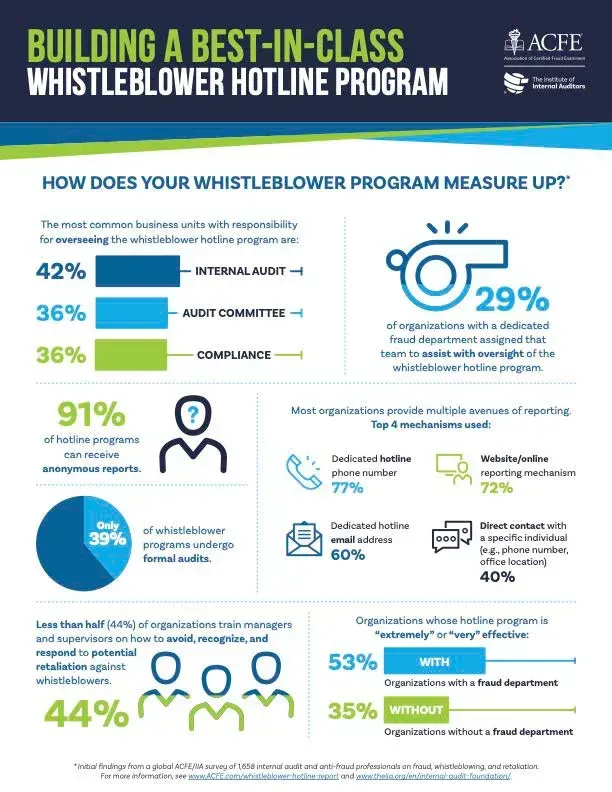Building a Wholesome Whistleblower Hotline Program

In today's business landscape, organizations face numerous challenges when it comes to
maintaining ethical standards
and
ensuring a safe and transparent work environment. One powerful tool that can help in this endeavor is a whistleblower hotline program.
This blog post will delve into the intricacies of building a wholesome whistleblower hotline program, highlighting its importance and the key components that contribute to its effectiveness.
Understanding the Importance of a Whistleblower Hotline Program
A
whistleblower hotline program serves as a vital channel for employees to report any wrongdoing, misconduct, or unethical behavior within an organization. It allows individuals to speak up without fear of retaliation and provides a platform to address issues that could otherwise go unnoticed. By encouraging open communication and accountability, organizations can build trust, maintain integrity, and safeguard their reputation.
Components of an Effective Whistleblower Hotline Program
To ensure the success and integrity of a whistleblower hotline program, several key components must be in place. These include:
Anonymity and Confidentiality: Ensuring that individuals feel safe and protected when reporting concerns is essential. An effective program should allow whistleblowers to remain anonymous and guarantee the confidentiality of their identity and information.
Accessibility and Ease of Use: A
whistleblower hotline program should be easily accessible to all employees, including remote workers. It should be user-friendly, with multiple reporting options such as phone, email, or online platforms, making it convenient for individuals to raise concerns.
Responsive Management: Promptly addressing and investigating reports is crucial for maintaining trust in the program. Organizations must have a dedicated team that handles reports professionally and confidentially, ensuring thorough investigations and appropriate follow-up actions.
Establishing the Whistleblower Hotline
To establish a successful whistleblower hotline program, organizations must consider the following steps:
Choosing the Right Whistleblower Hotline Service: Organizations can opt for an in-house solution or outsource to a third-party service provider. Careful consideration should be given to factors such as experience, reputation, and the ability to maintain confidentiality.
Setting Up the Hotline: Once a service provider is chosen, the necessary infrastructure, including secure communication channels and reporting mechanisms, must be established. This may involve creating dedicated phone lines, email accounts, or online reporting portals.
Promoting the Use of the Hotline: Ensuring widespread awareness and utilization of the whistleblower hotline is essential. Organizations should develop comprehensive communication strategies to promote the hotline, emphasizing its importance and assuring employees of its confidentiality and effectiveness.
Training and Awareness
To maximize the impact of a whistleblower hotline program, organizations should focus on:
Educating Employees About the Hotline: Employees need to understand the purpose, benefits, and procedures of the whistleblower hotline. Providing training sessions, informative materials, and regular reminders can help raise awareness and encourage reporting.
Training Management to Handle Reports: Managers and supervisors play a critical role in handling reports appropriately and ensuring a fair resolution. Organizations should provide training to equip them with the necessary skills to navigate these situations effectively.
Continuous Program Awareness: Building a culture of ethics and transparency requires ongoing efforts. Regularly reminding employees about the whistleblower hotline and reinforcing its significance can help keep the program at the forefront of their minds.
Monitoring and Improving the Hotline Program
Monitoring and improving the whistleblower hotline program is crucial to ensure its ongoing effectiveness and address any issues that may arise. By regularly reviewing the program's activity, addressing identified problems, and implementing changes for continuous improvement, organizations can maintain a robust and reliable reporting system. This section will explore the key steps involved in monitoring and improving the hotline program.
Regularly Review Hotline Activity:
Organizations should establish a process for monitoring and reviewing the activity of the whistleblower hotline program on a regular basis. This includes analyzing the volume and nature of reports received, identifying trends or patterns in the reported concerns, and assessing the effectiveness of the program in addressing those concerns. Data collected should be compiled and analyzed to gain insights into the overall functioning of the program and identify areas that require attention or improvement.
Address Identified Problems:
During the review process, organizations may identify issues or shortcomings in the whistleblower hotline program. It is essential to investigate the root causes of these problems and take appropriate actions to address them promptly. This may involve revisiting the reporting procedures, clarifying communication channels, improving response times, or enhancing the confidentiality measures in place.
Implementing Changes for Continuous Improvement:
Whistleblower hotline programs should be dynamic and adaptable. Organizations should regularly assess their program, incorporating improvements and updates to meet evolving needs and regulatory requirements. Based on the findings from the review process and the actions taken to address identified problems, organizations should implement changes to enhance the whistleblower hotline program. This can involve updating policies and procedures, revising communication strategies, providing additional training to employees and management, or introducing new technologies to streamline the reporting and investigation process. Continuous improvement should be an ongoing effort, with organizations regularly evaluating the impact of the implemented changes and making further adjustments as needed.
Engaging Stakeholders:
To ensure the success of the whistleblower hotline program, organizations should actively engage stakeholders, including employees, management, and the board of directors. Seeking feedback and input from these stakeholders can provide valuable insights into the program's effectiveness and areas for improvement. Regular communication with stakeholders can also help build trust and confidence in the program, reinforcing the organization's commitment to maintaining ethics and integrity.
Compliance and Regulatory Updates:
Organizations should stay informed about relevant laws, regulations, and industry best practices related to whistleblower hotlines. Regularly reviewing and updating the program to align with any changes in legal requirements ensures ongoing compliance and effectiveness. Engaging legal and compliance professionals can provide guidance on any necessary updates and help organizations navigate complex regulatory landscapes.
By monitoring the activity of the whistleblower hotline program, addressing identified problems, implementing changes for continuous improvement, engaging stakeholders, and staying updated with compliance requirements, organizations can maintain a robust and effective reporting system. This ensures that employees have a reliable mechanism to report concerns, promotes transparency, and helps foster a culture of accountability and integrity within the organization.
Conclusion
Building a wholesome whistleblower hotline program is a critical step towards fostering an ethical work environment and ensuring compliance with legal and ethical standards. By prioritizing anonymity, accessibility, responsiveness, training, and continuous improvement, organizations can establish a robust program that encourages employee reporting and contributes to the overall integrity and success of the organization.
Contact Turning Numbers for more information today!




